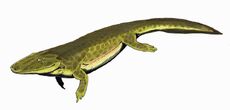
Tulerpeton
Tulerpeton is a fossil of an extinct genus of Devonian labyrinthodont that was found in the Tula Region of Russia at a site named Andreyevka. This genus and the closely related Acanthostega and Ichthyostega represent the earliest tetrapods.
Description[]
Tulerpeton is considered one of the first true tetrapods to have arisen. It is known from a fragmented skull, the left side of the pectoral girdle, and the entire right forelimb and right hindlimb along with a few belly scales. This species is differentiated from the less derived "aquatic tetrapods" (such as Acanthostega and Ichthyostega) by a strengthened limb structure. These limbs consist of 6 toes and fingers. Additionally, its limbs appear to have evolved for powerful paddling rather than walking.
The fossil fragments also indicate that its head was disconnected from the pectoral girdle. From the absence of the rough postbranchial lamina of the pectoral girdle, it has been determined that Tulerpeton had no gills and was therefore entirely dependent on breathing air.
Era[]
Tulerpeton lived approximately 365 million years ago,[1] in the Late Devonian period when the climate was fairly warm and there were no glaciers. Land had already been colonized by plants. During the Devonian period, the first truly terrestrial tetrapods – the ancestors of present day reptiles, birds, amphibians and mammals - first began to appear.